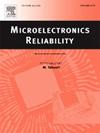Disentangling bulk and interfacial factors in solder joint reliability of fine pitch packages
IF 1.9
4区 工程技术
Q3 ENGINEERING, ELECTRICAL & ELECTRONIC
引用次数: 0
Abstract
This study evaluates the effects of solder alloy composition and pad surface finish on the mechanical strength and thermal aging behavior of solder joints in fine pitch BGA packages. Three lead-free solder alloys—Sn–1.2Ag–0.5Cu–0.05Ni (SAC1205N), Sn–1.0Ag–0.5Cu (SAC105), and Sn–3.0Ag–0.5Cu (SAC305)—were combined with three surface finishes (CuOSP, ENEPIG, and NiAu) to fabricate nine joint configurations. Mechanical integrity was assessed using ball shear testing (BST) and ball pull testing (BPT) both before and after isothermal aging at 150 °C (0–192 h). BST results indicated that solder composition—particularly Ag content—was the dominant factor in bulk joint strength, with SAC305 consistently demonstrating the highest shear resistance due to its Ag3Sn-reinforced microstructure. In contrast, BPT results emphasized the critical role of pad finish, with NiAu delivering superior interfacial strength through the formation of uniform Ni3Sn4 intermetallic layers. Statistical correlation analysis reinforced these trends, revealing a strong correlation between solder alloy and BST (r = 0.781, p = 0.013), and between pad finish and BPT (r = 0.695, p < 0.0001). Thermal aging accelerated strength degradation across all configurations; however, Ni-doped and high-Ag solders showed improved resistance to intermetallic coarsening. Fracture mode analysis and cross-sectional imaging further demonstrated that cohesive bulk failure in SAC305–NiAu joints correlated with stable interfacial morphology, while interfacial separation was more prevalent in CuOSP-based joints due to brittle IMCs and void formation. These insights highlight the stress-mode-dependent nature of solder joint degradation.
These results elucidate the differentiated contributions of bulk solder alloy and interfacial pad finish to joint performance under distinct mechanical loading conditions. In particular, the SAC305–NiAu and SAC1205N–CuOSP combinations demonstrated superior reliability, rendering them promising candidates for fine-pitch interconnects in high-performance applications. Overall, this study provides material-level design guidance for optimizing solder–pad combinations tailored to shear- or tensile-dominant loading in fine-pitch, high-performance electronic packaging.
细间距封装焊点可靠性的解缠体积和界面因素
本研究评估了焊料合金成分和焊盘表面光洁度对细间距BGA封装焊点机械强度和热老化行为的影响。三种无铅钎料合金sn - 1.2 ag - 0.5 cu - 0.05 ni (SAC1205N), Sn-1.0Ag-0.5Cu (SAC105)和Sn-3.0Ag-0.5Cu (SAC305)与三种表面处理(CuOSP, ENEPIG和NiAu)结合,形成九种连接结构。在150°C (0-192 h)等温老化前后,通过球剪切测试(BST)和球拉力测试(BPT)来评估机械完整性。BST结果表明,焊料成分(尤其是Ag含量)是影响整体接头强度的主要因素,SAC305由于其ag3sn增强的微观结构而始终表现出最高的抗剪切性。相比之下,BPT的结果强调了衬垫光洁度的关键作用,NiAu通过形成均匀的Ni3Sn4金属间层提供了优越的界面强度。统计相关分析强化了这些趋势,显示焊料合金与BST之间有很强的相关性(r = 0.781, p = 0.013),焊盘光面与BPT之间有很强的相关性(r = 0.695, p <;0.0001)。热老化加速了所有结构的强度退化;然而,ni掺杂和高银钎料的抗金属间粗化性能有所提高。断裂模式分析和断层成像进一步表明,SAC305-NiAu节理的内聚体破坏与界面形态稳定相关,而cusp节理中界面分离更为普遍,主要是由于脆性IMCs和空洞的形成。这些见解强调了焊点退化的应力模式依赖性质。这些结果阐明了在不同的机械载荷条件下,大块钎料合金和界面焊盘表面处理对接头性能的不同贡献。特别是,SAC305-NiAu和SAC1205N-CuOSP组合表现出卓越的可靠性,使它们成为高性能应用中细间距互连的有希望的候选者。总体而言,本研究为优化细间距高性能电子封装中剪切或拉伸主导载荷的焊盘组合提供了材料级设计指导。
本文章由计算机程序翻译,如有差异,请以英文原文为准。
求助全文
约1分钟内获得全文
求助全文
来源期刊

Microelectronics Reliability
工程技术-工程:电子与电气
CiteScore
3.30
自引率
12.50%
发文量
342
审稿时长
68 days
期刊介绍:
Microelectronics Reliability, is dedicated to disseminating the latest research results and related information on the reliability of microelectronic devices, circuits and systems, from materials, process and manufacturing, to design, testing and operation. The coverage of the journal includes the following topics: measurement, understanding and analysis; evaluation and prediction; modelling and simulation; methodologies and mitigation. Papers which combine reliability with other important areas of microelectronics engineering, such as design, fabrication, integration, testing, and field operation will also be welcome, and practical papers reporting case studies in the field and specific application domains are particularly encouraged.
Most accepted papers will be published as Research Papers, describing significant advances and completed work. Papers reviewing important developing topics of general interest may be accepted for publication as Review Papers. Urgent communications of a more preliminary nature and short reports on completed practical work of current interest may be considered for publication as Research Notes. All contributions are subject to peer review by leading experts in the field.
 求助内容:
求助内容: 应助结果提醒方式:
应助结果提醒方式:


